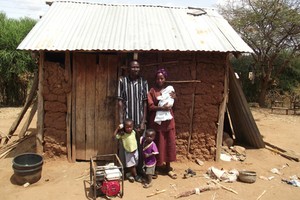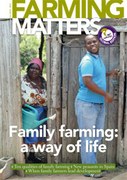Steven Kiranga Gichanga is a family farmer in Mugaari, a village in Kenya. He was trained in goat rearing but could not afford a goat to get started. He was also trained in bee keeping but could not afford a bee hive either. After a community reflection forum in 2012, Steven became aware of his own creative capacities and his ability to think outside the box. Then he came up with a brilliant idea.

A change in approach
Steven’s story is a good example of a people-led development approach, through which people’s needs, capacities, opportunities and priorities define development pathways. Caritas Embu is an organisation that now uses this as its guiding principle. In the past, we gave trainings in livestock upgrading, crop development and soil and water conservation in the hope that this would increase rural people’s food security. But we started to receive signals from staff and community members that this was not working for everyone. The poorest section of the population tended to be left out. They don’t always have land or money to invest in the technologies we promoted, such as hybrid seeds. When we shifted to a people-led development approach, we saw a radical change.
At first the change sounded threatening. We asked ourselves: if we need to change, does it mean that what we have been doing so far was wrong? Is the community able to take the lead? In the communities itself, people worried that material support was coming to an end.
Over time, people-led development nurtured in our minds, in our way of dealing with communities and in our style of facilitating activities. The communities also came to embrace it. We all started to realise that a people-led was an opportunity to realise the full potential of local communities which had been underestimated, unused or biased towards pre-set development measures. This transition took three years.
Local knowledge and practices
In the process, we learned a lot about the benefits of our new approach. People are more likely to reach their own development objectives when they are able to take the lead – even when these may differ from the expected results determined by NGOs. And, they are more likely to use their own resources and skills, which are abundant in Kenya.
For example, family farmer Isaac Kiringa from Mucaria does not need vets to treat his livestock. Instead he uses local herbs: a mix of taballo, ash and kales to cure goat bloat, or aloe vera sap mixed with pepper when his chickens are coughing. For human coughs, Isaac uses strings found between the back and the trunk of indigenous mururuku trees to chew on. For the treatment of malaria, roots of mukau (Melia volcansi), mutongu, mukarau, makara kara and muthwana trees are boiled with water. Traditional treatments are effective and free of cost to Isaac.
The region is also rich in indigenous, agro-ecological practices. This includes the use of livestock droppings to make compost manure, which is far cheaper than chemical fertilizers. Many people in the community use indigenous crop varieties that are resistant to drought.
In the new approach, farmers are encouraged to use resources available in the community to acquire what they need. Planting material can be acquired through seed exchange and community loans. “We figured that our own savings were a resource that we could rely on and use to start projects on our own,” Muringi Nicholas from Mbaraga village explains. “People feel responsible and their sense of ownership is growing, making their activities sustainable.”
Farmer-to-farmer learning

This approach encourages family farmers to engage in a reflection process in order to identify their local resources, climate specificities, locally adaptable farming systems and endogenous practices. Unlike indigenous customs (that refer only to local, traditional habits), endogenous practices refer to both local and external practices that can be applied in particular circumstances. For example, endogenous livestock rearing involves identifying breeds that can adapt well in a specific environment in a way that is both cost effective and environmentally friendly.
Transforming our role
As programme officers, we had to embrace a new role that would not overshadow the role of the community. The nature of our work has become more about facilitating a process rather than providing solutions or transferring knowledge. Because external expertise is not necessarily required to find local solutions, our role is not to promote anything but to guide farmers in a reflection about their challenges, needs, resources and priorities, and guide them through the process of defining the measures that are suitable for them and then setting about to achieve their goals. From different tribes and clans, people are now learning from one another and leading initiatives that build unity and cohesion in their communities. Farmers are now exchanging knowledge, quality seeds and planting material on their own, strengthening their farming systems and their livelihoods. As Caritas we have gained an important insight. If NGOs and donors want to truly support family farmers, it is crucial that they provide opportunities for farmers to decide their own development path, that makes use of their own skills and resources.
Laure Guibert was volunteering with Caritas Embu in Kenya. Contact: laureguibert@gmail.com. For more information about the programme write to Mary Mate, Programme Coordinator at marymate24@yahoo.com, or to Caritas Embu at doeadmin@orange.co.ke.

